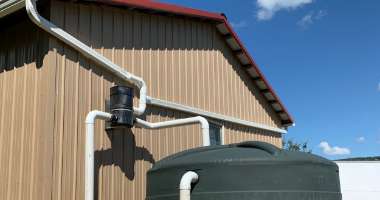Before we discuss how to harvest rainwater, let's examine this practice's many benefits. We can turn ordinary rainfall into a valuable resource by capturing rainwater directly from surfaces such as rooftops.
The importance of rainwater harvesting extends beyond mere water conservation. It's crucial in reducing the demand on our municipal water supplies and mitigating the effects of runoff on our urban infrastructure. In regions facing water scarcity, harvesting rainwater can provide a vital alternative water source, enhancing water security and sustainability.
The environmental benefits of rainwater harvesting are equally compelling. This practice helps prevent erosion and decrease the risk of flooding by reducing runoff. It also reduces water pollution, as less runoff means fewer contaminants washing into rivers and seas.
For homeowners and businesses, rainwater harvesting can lead to significant cost savings on water bills, particularly in areas with metered water use. For gardeners and farmers, it provides a source of chlorine-free water ideal for plants
Several design considerations are crucial for an effective rainwater harvesting system:
You can ensure your rainwater harvesting system is efficient, sustainable, and tailored to meet your water requirements through careful planning and designing. The goal is not just to collect rainwater but to do so in a way that maximizes its utility and minimizes waste and environmental impact.
An essential part of knowing how to collect water is knowing how much rainwater you can capture. The amount of rainwater you can harvest is related to a variety of considerations, including the size of your roof — known as the catchment area — and the average rainfall in your region. Thanks to our years of expertise and extensive knowledge, the experts at Rainwater Management Solutions can help you determine this figure. The amount you can collect will affect the size of the tank you'll install.
The conveyance system, namely your gutters and downspouts, is a critical component of any rainwater harvesting setup, serving as the vital link between the catchment area and the storage tank. Its primary function is to transport rainwater safely and efficiently without any loss. If you're using your existing gutters and downspouts, you'll want to inspect them to ensure
they're free of obstructions, splits, or cracks. If you're building new, you should consider several crucial factors:
The materials used for gutters and downspouts should be durable, non-corrosive, and suitable for water collection. Common materials include PVC, aluminum, stainless steel, and galvanized steel. Each has its advantages and considerations in terms of weight, longevity, environmental impact, and water quality. For example, PVC is lightweight and easy to install but may not be as durable as metal options. Aluminum, while rust-resistant and lightweight, can be more costly but is highly effective for long-term use.
The size of the gutters and downspouts is critical and should be proportional to the size of the catchment area and the intensity of local rainfall. Undersized gutters can lead to overflows during heavy rains, while oversized gutters may not drain properly, leading to stagnant water. The capacity should be calculated based on the roof area and the average rainfall, ensuring the system can handle peak flow without spilling or backing up.
You should install gutters with a slight slope toward the downspouts to help water flow and prevent pooling. The optimal slope typically ranges from 1/16 to 1/8 inch per foot of gutter. The layout should also ensure that downspouts are strategically placed to handle the water flow efficiently and direct it toward the storage tank without unnecessary detours.
Regular maintenance and proper sealing are essential to ensure the longevity of the conveyance system and prevent leaks. All joints and connections should be securely fastened and sealed to prevent water from escaping. Regular inspections, particularly after heavy rains or storms, can help promptly identify and address potential issues like blockages, leaks, or damage.
Ideally, the conveyance system should be integrated into the building's design in a way that is functional and aesthetically pleasing. This can involve custom solutions like hidden gutters or downspouts that blend with the building's exterior, ensuring that the rainwater harvesting system does not detract from the property's appearance.
See a smoothing inlet, one of the elements in the WISY Four-Step System, up close and learn about the difference it can make in your rainwater harvesting system.
TheWISY Four-Step System reduces maintenance requirements and improves water quality, which is why we recommend it to all our customers. The first component of the system is the pre-filter, which removes debris and aerates the water. Next is the smoothing inlet, which lies at the bottom of the tank and directs water upwards so it won't disturb the healthy biome below. The third element is the floating filter, which takes water from below the surface to send to the pump, reducing the amount of particulates that go to the pump and extending its lifespan. Lastly is the tank overflow device, which skims particulates off the water's surface and allows excess rainwater to escape.
Storage tanks are the heart of any rainwater harvesting system, serving as the reservoirs that hold the collected rainwater until needed. The design, sizing, and maintenance of these tanks are crucial for ensuring an efficient and reliable water supply. Here's a deeper dive into considerations for rainwater storage tanks:
Determining the correct size for your storage tank is critical and should be based on your typical water usage and the rainfall potential of your area. This involves calculating the average rainfall your catchment area can collect and balancing it with your daily or seasonal water needs.
Tanks can be made from different materials, including polyethylene and fiberglass. Each material has its drawbacks and benefits regarding durability, cost, and water quality. For example, polyethylene tanks are lightweight, cost-effective, and corrosion-resistant. Choosing the right material for your storage tank is essential for ensuring longevity and maintaining water quality.
Tanks can be installed above ground or below ground. Above-ground tanks are easier to install, but they can be susceptible to temperature fluctuations and may require more space. Below-ground tanks are less obtrusive and can maintain more consistent water temperatures, but they are generally more expensive to install. The choice between above-ground and below-ground tanks will depend on your property, budget, and personal preferences.
Keeping the stored water safe and clean is a priority. This involves designing the tank to prevent algae growth and contamination. Dark-colored tanks can help inhibit algae by blocking sunlight. The tank should be properly sealed to keep insects, animals, and debris from entering. Additionally, implementing overflow mechanisms and providing easy access for cleaning are crucial for maintaining water quality.
For those planning to use harvested rainwater for domestic purposes, the storage tank should be integrated with an appropriate pump system. It's also wise to consider how the rainwater system integrates with your existing water supply, particularly if you plan to switch between sources.
Consider future needs and the potential for expanding your rainwater harvesting capacity. Designing your system with the ability to add additional tanks or connect them in series can provide flexibility as your water needs grow or as rainfall patterns change.
Rainwater purification and filtration systems ensure the highest quality of water. They're vital if you intend to use your collected rainwater for indoor purposes. These systems can include:
Now that you know how to collect rainwater at home, the next step is putting your captured rainwater to good use. Here are some suggestions:
One of the most common and beneficial uses of harvested rainwater is irrigating gardens, lawns, and landscapes. Rainwater is naturally soft without the minerals, chlorine, and other chemicals found in municipal water, making it healthier for plants. You conserve your primary water supply and contribute to a healthier and more vibrant garden by using rainwater for irrigation. Drip irrigation systems, soaker hoses, or manual watering can all be adapted to use harvested rainwater, reducing your environmental footprint and saving on water bills.
A significant portion of domestic water use goes into flushing toilets. Using harvested rainwater for this purpose can lead to substantial savings on household water consumption. The transition involves connecting your rainwater storage system to your home's plumbing, specifically targeting the toilet supply lines. While this might require initial plumbing modifications, the long-term savings and environmental benefits are considerable.
Using properly treated harvested rainwater for indoor purposes, such as washing dishes and clothes, is an excellent way to extend the benefits of your rainwater harvesting system and further reduce your reliance on municipal water supplies. These activities constitute a considerable portion of daily water usage in typical households. You can conserve freshwater resources and contribute to a reduction in the energy and chemicals used in treating and pumping municipal water by switching to treated rainwater.
Rainwater is excellent for washing cars, windows, and outdoor areas. Its lack of hardness minerals means it's less likely to leave residue or spots, resulting in a cleaner finish. Using rainwater for these tasks reduces the demand on treated municipal water, conserves energy, and ensures that your car and outdoor spaces are cleaned in an eco-friendly manner.
Storing and using rainwater is an ancient practice that's been updated for the modern era. As a leading system provider, Rainwater Management Solutions is well-positioned to answer your questions about how to harvest rainwater. Read on for the information you need.
Rainwater harvesting involves collecting, storing, and using rainwater from surfaces such as roofs. This water can then be used for various purposes like irrigation, flushing toilets, and, with proper treatment, for washing dishes and clothes.
The cost varies based on the system's size and complexity and the materials used. Simple systems using barrels can be inexpensive, while more extensive systems with large storage capacities and filtration mechanisms can cost more. Prices generally can range from a few hundred to several thousand dollars.
Yes, but only if the rainwater has been properly treated to remove contaminants and pathogens. This typically involves processes such as sediment and carbon filtration and UV light disinfection. It's essential to ensure that the treatment system is adequate and the water quality meets local health guidelines before using rainwater for drinking.
Now that we've discussed how to harvest rainwater, you're ready for the next step. Rainwater Management Solutions offers customized rainwater harvesting systems suitable for homes or businesses. We can create a system that will help meet your rainwater harvesting goals. Contact us now and take advantage of the RMS difference.
 Rainwater Harvesting 101
Learn the basics of rainwater harvesting and what it can do for you. Read More
Rainwater Harvesting 101
Learn the basics of rainwater harvesting and what it can do for you. Read More  The Benefits of Rainwater Harvesting
Discover all the great advantages of installing a rainwater harvesting system. Read More
The Benefits of Rainwater Harvesting
Discover all the great advantages of installing a rainwater harvesting system. Read More  Whole House Water Filter Installation Guide
Get an in-depth look at the components of a whole-house filtration system. Read More
Whole House Water Filter Installation Guide
Get an in-depth look at the components of a whole-house filtration system. Read More